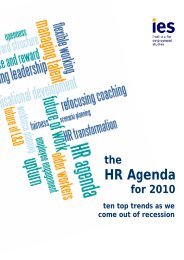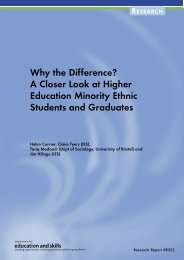Post-16 Transitions: a Longitudinal Study of Young People with ...
Post-16 Transitions: a Longitudinal Study of Young People with ...
Post-16 Transitions: a Longitudinal Study of Young People with ...
You also want an ePaper? Increase the reach of your titles
YUMPU automatically turns print PDFs into web optimized ePapers that Google loves.
who had a statement <strong>of</strong> SEN and/or had attended a special<br />
school were more likely to have done so than those <strong>with</strong>out a<br />
statement and/or who had attended a mainstream school.<br />
Parents <strong>of</strong> young people <strong>with</strong> sensory or physical disabilities<br />
were also more likely to have sought this type <strong>of</strong> information<br />
and support than any other SEN type.<br />
The majority <strong>of</strong> parents and carers seeking this sort <strong>of</strong><br />
information found that college staff were the most helpful (27<br />
per cent <strong>of</strong> those seeking information), followed by doctors<br />
and health workers (17 per cent), and social workers/<br />
probation workers (11 per cent).<br />
Table 6.11 illustrates the type <strong>of</strong> information and support that<br />
parents and carers received, however, this primarily fell into<br />
the following categories:<br />
• information<br />
• an explanation <strong>of</strong> the options available<br />
• help to plan additional support for the young person, and<br />
• helped young person to make decisions.<br />
Seven per cent <strong>of</strong> all parents and carers also sought published<br />
information and advice on the young person’s special<br />
Table 6.11: Support provided<br />
N = %<br />
Provided information 235 34<br />
Explained options available 119 19<br />
Helped in planning support for her/him 118 19<br />
Helped her/him in decision making 53 8<br />
Did not help/provide support at all 27 4<br />
Assisted <strong>with</strong> education/training 13 2<br />
Provided equipment/appliances 13 2<br />
Helped assess/categorise the young person's condition 12 2<br />
Helped him/her to progress to work/further education/training 6 1<br />
Held meetings/discussions 6 1<br />
Other 22 4<br />
Don't know 9 1<br />
N = 417<br />
Note: All percentages are weighted percentages, unless otherwise stated<br />
Source: IES/MORI 2003<br />
<strong>Post</strong>-<strong>16</strong> <strong>Transitions</strong> <strong>of</strong> <strong>Young</strong> <strong>People</strong> <strong>with</strong> SEN: Wave 2 107

















